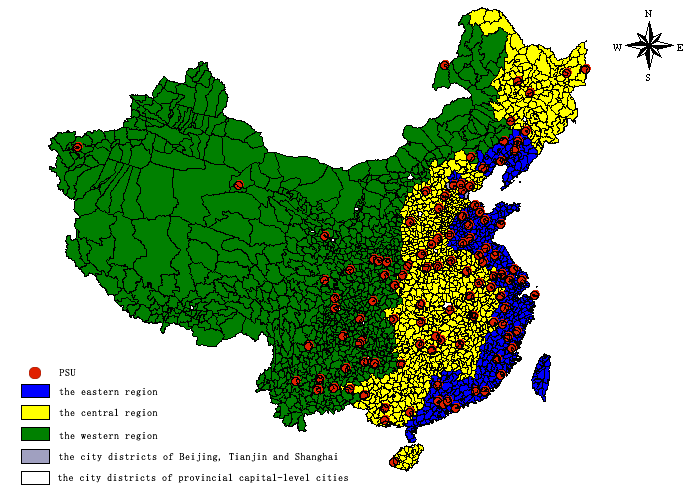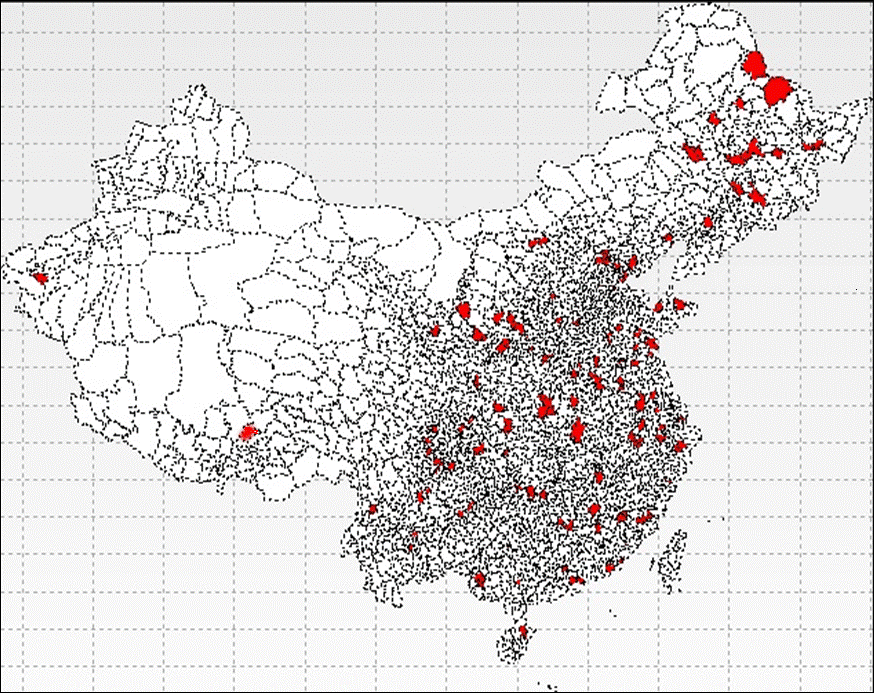Since 2003 ,the CGSS has three different sampling designs and has used three set of sampling frames. They are 2003-2006, 2008, and 2010-present. The targeted population of the CGSS are civilian adults aged 18 and above. 2003–2006 sampling design uses China’s fifth census of 2000 as sampling frame. The sample is composed of 5900 urban households and 4100 rural households. The urban sample is over sampled, for we hypothesize that the heterogeneity in urban area is higher than in rural area.
The 2003-2006 sampling design is multi-stage stratified design.The sampling stages are as follows: (1) At otal of 125 primary sampling units (PSU) are selected for the national sample;(2) Four secondary sampling units (SSU) are selected in each selected PSU; (3)Two third-level sampling units (TSU) are selected in each selected SSU; and (4)Ten households are selected in each selected TSU. One eligible person aged 18-above (18-69 for2003) is randomly selected from each sampled household to serve as respondent. PSUs are county-level units. There are 2801 PSUs.
in 2000 census data, from which 125 PSUs were selected by following these procedures: First, within each stratum, all PSUs are ranked according to the percentage of eligible respondents with a middle education or higher level; and second, a given number of PSUs are selected by using a method of “proportionate to population size”; in this procedure, population refers to civilian population aged 18 and above. These lection of secondary sampling units (town ships [xiang], towns [zhen], and city subdistricts [jie dao]) and third-level sampling units (villages [cun] and neighborhood committees [ju wei hui]) follow the sample procedures as used in the selection of PSUs. The 2801 PSUs(county-level units ) are classified into five strata. The first stratum consists of the urban areas of the three municipalities under the central government: Beijing, Shanghai, andTianjin; the second stratum consists of urban areas of Chongqing and 26 provincial capital cities (Lhasa is excluded); the third, fourth, and fifth strata are designed for the eastern, middle, and western regions, respectively. The five strata and selected PSUs are as figure 1.
Figure 1: Strata and PSUs of the CGSS Cycle I

In such a radical change society as China, a sampling frame will become out of date soon. From 2003 to 2006, this problem has been becoming more and more serious. In 2008, CGSS used a experimental sampling design, which canceled the Stratum 2 of 2003-2006 design – the provincial capital cities. So there are only five stratain 2008 design: Big-3, east, central, and west. And the 2008 design used 2005 1% national population survey data assampling frame. For it is just an experimental design, the 2008 CGSS sample size is only 6000.
The sampling design made in 2010 for the CGSS Cycle II used 2009 national population data assampling frame. 2010 design is still multi-stage stratified design. There are 3 sampling stages: PSUs is county-level units, there are 2762 PSUs in the sampling frame; SSUs are community-level units(villages [cun] and neighborhood committees [ju wei hui]); in selected SSU, 25 households(TSUs) are sampled with PPS method; in each selected household, 18 and above adult will be sampled with Kish grid. There are 43 Municipalities directly under the central government, provincial capital cities, and vice provincial cities in China. Comprehensive ranking by GDP, FDI and Education Level to these cities, the top 5 is Beijing, Shanghai, Tianjin, Guangzhou, and Shenzhen. The 2010 design set these 5 cities as self-representative stratum. This stratum consists of 67 PSUs. The rest 2695 PSUs are comprehensively ranked with GDP per capital, urbanization rate, and population density and then are equally classified into 50 strata. Within each stratum, 2 PSUs will be selected with PPS method. In each selected PSU, 4 communities are sampled with PPS method. There are 80 communities in self-representative stratum and 400 communities in the rest 50 strata. The total sample size of 2010 design is 12,000 households and 2000 are in self-representative stratum. The selected PSUs of 2010 design are as figure 2.
Figure 2: PSUs of the CGSS Cycle II
